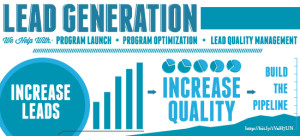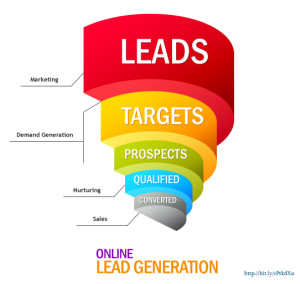by Carol Springer | Sep 23, 2015
It is becoming more clear that buyers want to and in many cases are able to control the entire selling process – from introduction to education to closing. With the abundance of information that is available through digital content, a buyer no longer needs to rely on the seller to facilitate the process. DemandGen Report released a study in June of 2014 detailing that “75% of B2B buyers rely more on content to research and make B2B purchasing decisions than they did a year ago.”
The shift in roles raises a question: what role should the traditional sales rep serve in today’s B2B transaction?

This blog will address this question and outlines the first opportunity a traditional rep typically has to engage with a prospect. The inside sales rep is as important now that buyers are empowering themselves, but to stay relevant, they must adapt the way they apply their efforts. Marketing and sales cannot sit in two different silos any longer to remain effective.
Zig Ziglar, an American icon and renowned sales educationalist, found that “Every sale has five basic obstacles: no need, no money, no hurry, no desire, no trust.”
Any experienced salesman or marketer has been exposed to these five objections regularly throughout dealing with prospective clients. The content marketing boom has resulted in a sixth hurdle that plagues today’s new business development efforts: no education.
In today’s digitally dominated marketplace, new innovations present themselves regularly that provide opportunities to increase efficiency and reduce costs. Proactive buyers will have familiarized themselves with an opportunity area well-before you have the chance to reach them.
Below you will find a list of 6 questions that aim to accomplish three things during a first conversation between sales rep and prospect:
- Build a persona of the buyer
- Identify their awareness, needs, and capabilities
- Provide relevant sales content
(These questions will be staged as if they are being utilized by a firm that provides a marketing automation SaaS product)
How does your team utilize marketing automation to help assist in generating your pipe?
A question along these lines can serve several purposes. In the context of the hypothetical provided, it will allow the sales rep to immediately discern the level to which the prospect has adopted marketing automation technology. This can range drastically from total lack of awareness that the technology exists to them already operating at an SAP-type complexity.
Identifying the level of utilization the prospect has early in the conversation is crucial to pushing the appropriate level and type of content to move the buyer forward in the process. With this information in hand, it becomes simple to identify what information will be relevant and needed to move the call forward.

Would you be the best person to share information with about marketing automation and helping improve the efficiency of your pipe?
Discerning whether or not you are interacting with the appropriate decision maker allows you to expedite your sales cycle. More and more sales require multiple personnel to sign-off in order to mitigate fear and potential risk. Budgets are constrained now more than ever, and convincing decision makers to give you a piece of their cherished pie is something you and many others are trying to accomplish at the same time.
The number of gatekeepers that sales reps have to navigate has increased as well. An answer to this question will provide insight as to how close your prospecting efforts have led to you reaching a lead with decision making authority.
What are the steps your company typically takes when they are evaluating a new solution or technology?
Securing a sale requires that you know what it is that your customer wants so that you can effectively provide it for them. What’s the best way to figure this out? Ask them about their buying process.
Knowing the steps a company takes to evaluate an offer allows you to identify the key metrics they use and consequently what is most important to them. You can capitalize on this knowledge throughout the steps of their process by providing relevant content that aligns your solution with their needs.
It’s also crucial to know the urgency with which the prospect wants to acquire a new solution. Trying to expedite this process with efforts other than pushing content (i.e. “the hard sell”) is the quickest way to discourage prospects with slow buying cycles.
Have you looked into any marketing automation solutions before?
This question provides insight into how familiar the lead is with the technology or solution you offer. You can gauge their level of interest and education related to the space and whether you are competing against other available offerings in the space or a technology that’s already ingrained within their corporate culture.
Are you familiar with our company at all?
Although simple, this question helps immensely in discerning both the prospect’s familiarity with your offering and their willingness to be further educated in the matter. Just because a lead gives off the impression they don’t want to engage with you, you can still distill opportunity by providing them relevant content that will help move them along the sales cycle at their own pace.
I know schedules are tight – is there a time that would be best for me to follow-up and just answer any questions you may have?
Asking a question in this manner communicates that you respect their time and are willing to allow them to control the way they are sold to. If they demonstrate actionable interest in your offering early on, capitalize on the opportunity. However, for the vast majority, catering to their interests and avoiding the hard sell will help fill your pipe in the most effective manner.
Always keep in mind what your questioning is aiming to accomplish, and that you may need to adapt your process at any point to cater directly to the stage of buying your prospect is in.
Please contact us if you would like to learn more about our sales strategy.
by Carol Springer | Sep 8, 2015
Content marketing is making huge strides in the sales process. Why? It is effective.
Content keeps people engaged without sales calls and content is scientifically better at impacting people. You may already know that videos have a higher retention rate than text, but did you know that stories trigger the brain more than just facts and figures. It is recommended to incorporate story telling into marketing in order to relate to your audience, appeal to emotions and engage their brain more.
The idea behind story telling is to show not tell. When using facts and figures to portray an idea or product you will only engage two parts of your reader’s brain, the Wernicke’s Area (language comprehension) and the Broca’s Area (language processing). Using stories you can trigger multiple areas of the brain by describing the surroundings, Motor Cortex (movement), Sensory Cortex & Cerebellum (touch), Olfactory Cortex (scents), Auditory Cortex (sounds) and Visual Cortex (colors and shapes). By triggering more areas of the brain you are making it more likely that your audience will remember your content.
It is easy to learn how to market a product through storytelling.
There are 5 key steps to telling a successful story:
- Get Personal – connect with your audience emotionally. Appeal to the pains they may be experiencing without your solution.
- Avoid Clichés – they have minimal impact and are more likely to drive people away than engage them.
- Avoid Complex Language – keep your story conversational to create a more enjoyable experience rather than overwhelming your audience.
- Be Relatable – add meaning for the audience.
- Be Descriptive – take advantage of describing scenes in order to activate more areas of the brain in order to be more memorable.
In order to successfully engage with the audience you also need a hero they can connect with 5 things the hero must do in order to engage your audience:
- Sets out to achieve a goal.
- Butts heads with an antagonist or a problem that needs to be solved.
- In order to conquer the hero must make a transformation.
- Finds a mentor with resources.
- The hero prevails!
 In order to practice what we preach we wrote a story about ‘John’ who is struggling to maintain sales. This is just one example of how to market a product with storytelling. Continue reading in order to learn what actions John takes to alleviate his sales woes.
In order to practice what we preach we wrote a story about ‘John’ who is struggling to maintain sales. This is just one example of how to market a product with storytelling. Continue reading in order to learn what actions John takes to alleviate his sales woes.
John sits at his desk, a nearby copy machine whirrs, and the clock chimes 8 times. It’s the start of a new work day. The same daunting task looms before him as it had for days and weeks and months.
John needs a way to sell, market and close deals efficiently and cost effectively. As he braces for the chaos that is about to begin, he glances over at the stainless steel framed photograph of his family. It has been weeks since he has made it home for dinner. He is lucky if he makes it home to tuck them in.
As owner of the company John has many functions. His days are filled with company operations, client management, proposal creation and employee management. Lately his time has been devoted to hiring and training sales reps. Due to the nature of the industry, the sales process is long, which makes the training process longer.
Last month John had to replace their last sales rep because goals were not being met. John has since picked up the sales calling while training the new sales rep. Before John picks up the phone for his first round of calls he runs his fingers through his graying hair and wishes there was an easier way to sell.
This led John down a rabbit hole of internet searches for a sales and marketing solution. What stood out as the best option for John was outsourcing.
Fast forward two months.
John is sitting in a conference room filled with people determined to cure his sales and marketing pains. They previously mined John’s company for existing content and learned the sales process. These people were now going to change the selling process and with John’s help, create fresh content.
Outsourcing and how to market a product is new to John and he is nervous it won’t work. In this monochromatic room, tan walls and brown furniture, he tries to turn his fears and doubts into confidence. If this is successful the ROI will be substantial, not to mention the time and money that will be saved by not having to hire new sales reps every six months.
The outsourcing team created content to address frequently asked questions. As John supplied information for content he quickly realized that each piece had a specific purpose within the sales process. Content was not being created solely for marketing; it was being created with sales strategy in mind.
After two days with the sales and marketing outsourcing team John was feeling confident. Two weeks following content creation, cold callers hit the phones and pushed the first wave of content. Using cold callers lowered the cost of calling for John and increased the volume of calls made.
Through cold calling and trackable content each prospect was scored. The scoring made it possible for John’s heavy hitting sales person to focus on prospects that showed interest. John was still the closer and was brought in early to guide buyers through the sales process. Although John’s initial headaches were gone he had a new one.
Cold calling, content nurturing and focusing on interested leads meant John was working to close more deals than ever before. Most of his calls involved explaining their solution and he was feeling like a broken record. John was getting involved too soon. John wondered, “Is there a way to get people the right information without getting tied up on the phone?”
He called his sales and marketing outsourcing team and explained his challenge. They proposed to automate the sales process with content. Together they created headshot, demo and whiteboard videos in order to clone John and get the information in an easily shareable form.
Now, sales reps could send prospects pertinent information through a marketing automation platform. The data was tracked and if the content was viewed the prospect could move to the next step in the sales process.
John’s time was further leveraged by bridging the information gap with content. He was spending less time involved in the sales process and the company was working more deals than ever. John was working less hours and spending more time with his family.
Today John sits at his desk, sipping coffee while he views marketing automation reports. His reports show that two clients viewed videos on how to calculate ROI. Today is the day to get them to buy. Before picking up the phone, John smiles to himself and thinks, “Two sales a day and only two calls. Not too bad.”
To learn more about how to market a product with content, check out these blogs:
Get Prospects to Take Action: Content Variety
How to Guide B2B Prospects through the Sales Cycle with Content
by Carol Springer | Sep 8, 2015
Today’s B2B marketing environment is rapidly progressing with the abundance of tactics that are available and easy to adopt in the digital space. The purpose of this blog series to outline four simple tactics to help boost the effectiveness of your sales and marketing processes, while increasing quality lead generation. This blog, the first in the series, will discuss why you need to shift your channel strategy i n order to maximize your marketing efforts, and ultimately close more business. Additionally, the impact of partnering with a company that does B2B marketing outsourcing and how they can sometimes be more effective than even the best internal teams will be discussed.
n order to maximize your marketing efforts, and ultimately close more business. Additionally, the impact of partnering with a company that does B2B marketing outsourcing and how they can sometimes be more effective than even the best internal teams will be discussed.
The first point of note is that it makes sense for any company, large or small, struggling or successful, to consider utilizing an outside partner in executing aspects of their sales, marketing and lead generation processes. Outsourcers can be hyper-effective in managing some or all aspects of a B2B company’s sales and marketing process.
Adopt A Multi-Channel Strategy
In today’s rapidly evolving B2B market, most companies can no longer rely on a single channel to produce enough closed business to stay ahead of the competition. You have to provide the opportunity for your buyers to when and how they so choose as there has been a dramatic shift in how to sell effectively. No longer can you try and drive buyers through your sales process; you have to help them through their buying process. Your choices are numerous and not all channels will generate closed business equally, depending on the nature of your business and the vertical you operate in.
How then is a business to decide which additional channels to pursue when there are so many available especially with the proliferation of the digital space?
First, it is imperative that when you pursue a new channel (or channels), you do so in a way that you are able to measure the effectiveness of the investment, so you can determine downstream whether it is something worth continually pursuing. There are many sources for data on which channels have proven the most effective within specific industries, so entities like Forrester or Marketing Sherpa are a great place to start, as well as analyzing your own historical data. Just remember to design your new approach/strategy in a way that you will be able to return actionable metrics from your efforts.
So then after you have chosen which channels you would like to expand into the question remains: “How should I execute this new strategy? Should I have my internal team try and tackle the extra workload? Should I hire additional personnel with expertise in the area?”
All three options are viable for moving your initiatives forward, which leads to the final question: “What is the most cost effective way to accomplish this new initiative?” The remainder of this blog will discuss how utilizing an outside partner can in many cases be the most cost conscious and effective strategy to expand your channel marketing.
B2B Marketing Outsourcing
Companies that specialize in outsourcing business processes are not a new concept. It is important to select a partner that you trust to handle such a crucial area of your business, because you are going to have to be willing to rely on their experience, expertise and methods to effectively help you close more business – because at the end of the day that’s what matters most for any organization.
Some outsourcers specialize in specific channels while others offer a more full-service approach and have the ability to successfully navigate multiple channels with an integrated approach. First things first, ensure that you select and organization that will provide transparency and robust success metrics of their efforts so you can accurately assess the ROI of your new relationship. However, it is important to point out that the most successful relationships are built on trust, and attempting to micro-manage a partnership like this can many times hurt the success of the campaign – you have to let the experts do what it is they know best, yet hold them accountable through metrics and transparent reporting.
In the next blog in this series, we will discuss the importance of pursuing lead quality over quantity, and how shifting your focus on lead generation can directly result in more effective sales teams and more closed business.




 n order to maximize your marketing efforts, and ultimately close more business. Additionally, the impact of partnering with a company that does B2B marketing outsourcing and how they can sometimes be more effective than even the best internal teams will be discussed.
n order to maximize your marketing efforts, and ultimately close more business. Additionally, the impact of partnering with a company that does B2B marketing outsourcing and how they can sometimes be more effective than even the best internal teams will be discussed.